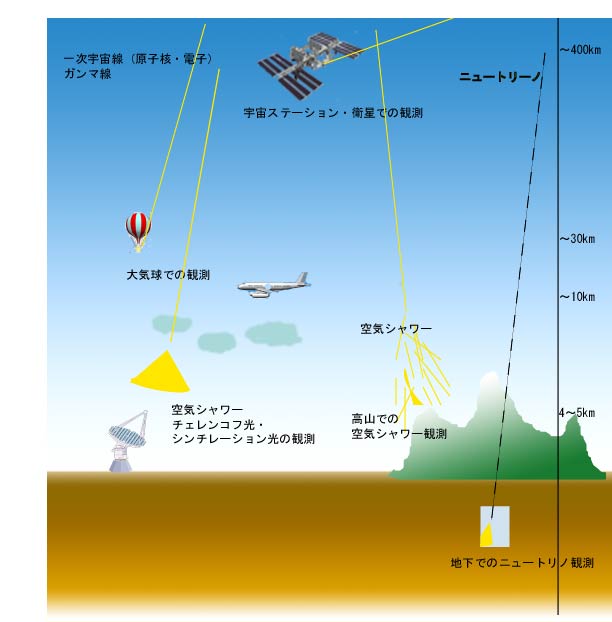Recent Topics
- 2025/09/16Conference Presentation
- Mr. Kobayashi(a first-year master's student) presented his research at the meeting of the Physical Society of Japan.
- 2025/09/16Conference Presentation
- Mr. Hirose(D3 student) presented his research at the meeting of the Physical Society of Japan.
- 2025/07/10Published Paper
- "Precision Spectral Measurements of Chromium and Titanium from 10 to 250 GeV/n and Sub-Iron to Iron Ratio with the Calorimetric Electron Telescope on the International Space Station", Phys. Rev. Lett.
- 2025/05/27Discussion Meetin
- Graduate student Mr. Hirose held a seminar.
- 2025/05/12International Conference Presentation
- Mr. Hirose(D3 student) presented his research at the international conference.
- 2025/04/28Doctoral Dissertation Public Defense
- Mr. Okugawa's doctoral dissertation public hearing was held.
- 2025/03/25Research Presentation
- Mr. Okugawa from D3 presented his research at the 8th Workshop on "the Origin of Cosmic Rays through Air Shower Observations".
Exploring the Universe and Nature with Cosmic Radiation
The Cosmic Ray Laboratory observes high-energy radiation (cosmic rays) and cosmic gamma rays that carry diverse information from space as they travel to Earth, studying phenomena occurring in outer space and astronomical objects.These observations utilize a phenomenon called “air showers,” created by cosmic rays interacting with the atmosphere.
We also conduct atmospheric physics research using air showers. Additionally, we develop radiation detectors, analysis software, and electronics for cosmic ray observation, and conduct research using Monte Carlo simulations.
What is cosmic ray research?
- High-energy particles and gamma rays originating from astronomical sources and space are called cosmic rays and cosmic gamma rays. Cosmic rays were discovered in 1912 by Austrian physicist Victor Hess, who was later awarded the Nobel Prize in Physics for this work.
- Cosmic rays originating from astronomical objects in our galaxy are primarily protons and other atomic nuclei, traveling at speeds close to the speed of light. Since that discovery, the questions of where cosmic rays come from and how particles are accelerated to such speeds have been the subject of debate among scientists. In recent years, it has become increasingly clear that celestial objects known as supernova remnants are the origin of high-energy cosmic rays. Yet, many unknown phenomena and unresolved problems remain.
- Furthermore, cosmic rays and cosmic gamma rays carry information about phenomena occurring in the cosmos back to Earth. Just as we observe stars with telescopes, measuring cosmic rays and cosmic gamma rays allows us to understand what is happening in distant places.
-

Flux Distribution of All Cosmic Rays (from Simon Swordy) The energy of cosmic rays reaches ultra-high energy unattainable artificially, with individual particles reaching 1020²electron volts. Such ultra-high-energy particles are thought to be produced by physical phenomena associated with violent celestial activity, but their origin remains unknown and constitutes an important research topic.
- Cosmic rays interacting with atomic nuclei (oxygen, nitrogen) in Earth's atmosphere generate numerous secondary particles. These include pions and photons produced by their decay, as well as muons. The photons further create numerous electrons and photons, and this massive particle shower ("air shower") reaches the ground. Cosmic gamma rays and cosmic electrons also create air showers.
-
Observations of air showers are conducted by installing numerous detectors on the ground and at high altitudes.
Highly penetrating particles such as muons and neutrinos are observed using detectors placed underground.
Furthermore, to directly observe cosmic rays before they interact with the atmosphere, detectors are carried aboard balloons, satellites, and space stations for observation.

- Our laboratory is conducting air shower observations at the Yangbajing Plateau in Tibet (elevation 4300m) in collaboration with the Institute for Cosmic Ray Research of Tokyo University, other universities nationwide, the Chinese Academy of Sciences, and Chinese universities. ("TibetASgamma Project"). Currently, we are advancing a new observation experiment ("ALPACA Project") on Bolivia's Chacaltaya Plateau with research institutions from Japan, Bolivia, and Mexico, aiming to observe cosmic gamma rays in the southern galaxy. We are also participating in the direct cosmic ray observation experiment on the International Space Station ("CALET Project").


